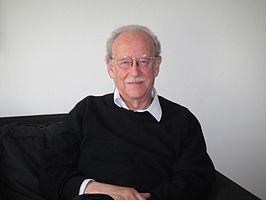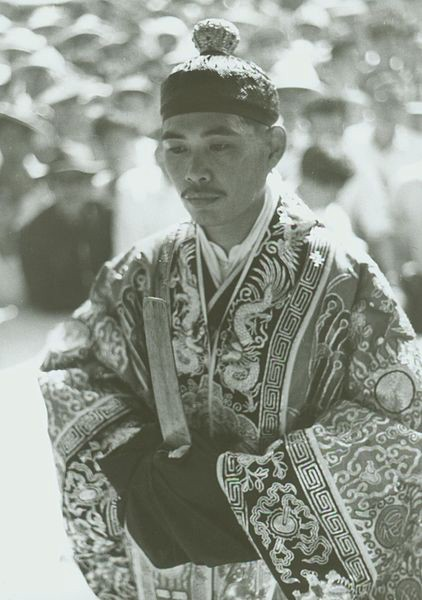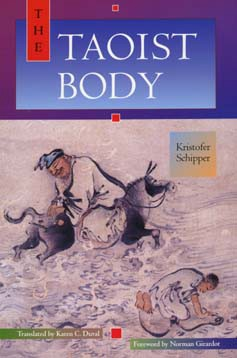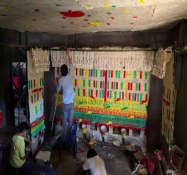


Kristofer M. Schipper enshrined at the Xuanmiao guan Daoist temple in Suzhou. Art credit: Huizhentang. Photo credit: Tao Jin via www.daoisms.org
My doctoral mentor, Kristofer Marinus Schipper (1934— 2021) passed away on Feb. 18, 2021.
I met Schipper during my first year of graduate studies in Paris, in 1995–96. I took his Saturday morning seminar at the Ecole Pratique des Hautes Etudes, in the dusty old Salle Marcel Mauss in a corner of the Sorbonne. Schipper was a legend in Daoist studies, and for most of the year, I followed the seminar trying as best as possible not to be noticed, during the two hours of study of texts of the Daoist Canon, followed by an hour-long lecture on “Chinese ethnopsychiatry,” i.e., religious healing practices in the Chinese and Daoist traditions.
Toward the end of the year, I approached him, asking if I could be his doctoral student. “No. I’m retiring soon, and I’m not taking any new students”. But I insisted, and gave him my masters’ thesis containing my initial findings on the qigong movement in China. The following week, he accepted to be my directeur de thèse.

Kristofer M. Schipper in 2009. Photo credit: Yuan Bingling via nl.wikipedia.com.
As a mentor, Schipper was strict and intimidating. I felt out of place among the students in his seminar, who all worked on Daoism in early historical periods — for them, “modern Daoism” started in the Song dynasty, over a millennium ago! Researching the Qigong movement in the mainland Peoples’ Republic of China, I was the only person who wasn’t studying historical texts, or doing fieldwork on traditional Daoist rituals. I was working on a decidedly contemporary phenomenon, very much a wave of “new religious movements,” a re-invention of elements of Daoist tradition under post-Mao socialism. But Schipper saw this as an important chapter in the contemporary history of Daoism, and he was keen that I write that story.
We were not close, but I deeply respected him, and his influence on my work was profound. I owe him my career, and am immensely grateful to him. The advice he gave me saved me from certain failure, and laid the foundation for the success of my research.
I am an anthropologist by vocation. I wanted to do field research and participant observation, and I was attracted to the French tradition of Claude Lévi-Strauss. Schipper had done ten years of field research among the traditional Daoist masters of Taiwan in the 1960s, leading to his ordination as a Daoist priest. His seminars were dazzling intellectual performances. He would start by sharing photocopies of an obscure text of the Daoist Canon, perhaps from the Han dynasty, and would start reading and commenting. Sometimes, after reading only one or two sentences of the text, his commentary would become an hour-long impromptu digression, unpacking a single term, linking it to other terms in the text and other texts, expounding on its significance, evoking anthropological theories and examples from India or other cultures, touching on contemporary debates and discussions, chanting the text as he had learned in Taiwan.
He was, perhaps, the last true Sinologist: he could speak with authority and deep understanding about virtually any period of Chinese history, from the Warring States to the contemporary period. His mastery of textual study was unsurpassed, as was his years of field research, which took him deep into the popular strata, where, ignored by elite scholars, the Daoist tradition still lived. Almost single-handedly, he founded the academic field of Daoist studies.
Prior to Schipper, only a tiny handful of scholars, in France and Japan, had paid any attention to Daoism. The general consensus was that there was nothing of interest in Daoism, which, in any case, had disappeared. Nobody knew how Daoism was practiced, and nobody knew how to make heads or tails of the 1476 texts — most of which indicated neither author nor date — of the Daoist Canon, of which there were only a handful of copies remaining. Through his academic “discovery” in the field of southern Taiwan, he showed that Daoism still lived among the people. His students, followed by many other scholars, have continued since then to study how Daoism exists as a lived tradition, rather than as a trope of philosophers or New Agers.

Young Daoist master on his way to his initiation in the Zhengyi order, in Gangshan, Taiwan, 1963. Photo credit: Kristofer Schipper, 1963 via Wikimedia Commons.
Following his time in the field, his main life’s work was in his leading an international team that conducted the first ever systematic study of the Daoist Canon. The textual tradition was given legibility, clarity, and dignity through the work of Schipper and his team. After the Handbook on the Daoist Canon was published in 2005, the foundation of the field of Daoist studies was established.

Kristofer Schipper and Franciscus Verellen eds., The Taoist Canon: A Historical Companion to the Daozang. Chicago: University of Chicago Press, 2005.
There was a connection, though, between Schipper’s textual work, which was inevitably historical, situating texts in their historical context, and his field work: Daoism in the field is primarily a ritual tradition; and most of the texts in the Canon are ritual texts. No matter how Daoism is approached, taught Schipper, embodied ritual practice is the key. The embodiment is both individual and social. This unified approach transpires in Schipper’s masterpiece, The Taoist Body. The narrative starts with the festivals of the people, and ends with the mystic flights of Zhuangzi. Chapter by chapter, the book advances seamlessly, in a steady progression, from the practices of the common people, to the training of the Daoist masters, to the cultivation of the body, and to the realms of the Immortals. Most accounts of Daoism treat these dimensions as distinct fragments, focusing on one to the exclusion of the others. But the Taoist Body takes the reader on an initiatory journey. The connections between the chapters reveal as much as the content of each. Yes, it’s an academic work — still unsurpassed as an introduction to Daoism, since its first publication in 1982. But it’s so much more than an academic work.

Kristofer M. Schipper, The Daoist Body. University of California Press, 1993.
Read it again. And again. The book is alive. The Daoist body is a living, immortal body. Not just the individual body, but the social body. The social body of Daoism is a living body. And this is, to me, the most important lesson to be gained from Schipper.
Regrettably, he never published a detailed ethnographic account of his field research in Taiwan. But he took into himself the life of the Daoist lineage and community he studied — and through him, and his passion, the texts he taught, the histories he narrated come to life.
Contemporary academic paradigms love fragments and detest essences. These paradigms would lead us to question whether something called Daoism really exists. Schipper was no peddler of a simplistic Daoist holism. He was rigorously empirical, historically minded, attentive to difference. But for him, the priests at the Emperor’s court, the masters and mediums in the remote villages, the Celestial Master ritualists, or the Western Tai Chi practitioners — all are expressions of a single living Daoist tradition. And, he never ceased to insist, this tradition is the true body of China — its zhuti. This was the controversial proposition he put forward.
Step by step, piece by piece, he and his students, and the growing community of Daoist studies, through their research, have given flesh and life to this account of China’s Daoist body, and to its centrality in China’s history, from ancient times until the present. This is China’s yin body — the body of the lowly people in the shadows, the invisible, overlooked source of China’s life — in counterpoint and resonance with China’s yang body draped in a Confucian and, later, Socialist robe. This is the path, the Dao of Daoist studies that Kristofer Schipper called on us to follow.
* * *
My research team at the University of Hong Kong’s Yao Dao Project, have decided to dedicate our project to the memory of Kristofer M. Schipper. We hope that our research can fully exemplify the conjunction of textual and anthropological research, attentive to the conjunction of Daoist and local cultures. For more information, see here:

Yao Dao Project
The Yao Dao Project has conducted systematic anthropological research through participant observation on the culture…
yaodaoproject.com
Please see below for interviews of Kristofer Schipper, filmed at the Chinese University of Hong Kong in 2007 as part of a conference on Religion and Chinese Society that I co-organized with Vincent Goossaert and Peter Ng, and as part of the audio-visual component of the Chinese Religious Life book and website project:
Click here for my review (in English) of Schipper’s book The Religion of China: The Living Tradition, a compilation of his most important and influential articles, published in French in 2011.
Click here for Schipper’s foreword to the volume Daoism in the Twentieth Century: Between Eternity and Modernity (University of California Press, 2012) which I co-edited with Xun Liu.
Click here for a description and photos of a memorial service held for Schipper at the Xuanmiaoguan Daoist temple in Suzhou.
See below for a commemorative event held online by the Society for the Study of Chinese Religions, featuring eulogies by leading scholars, collaborators and students of Schipper: